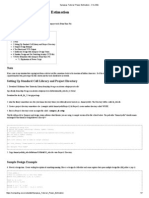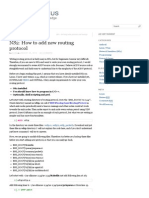C# Factory Pattern
Uploaded by
Shrishalini KumarC# Factory Pattern
Uploaded by
Shrishalini Kumar2/24/2014
C# Factory Pattern
C# Factory Pattern
A factory creates objects. We implement the factory design pattern in a C# program. With this pattern, we develop an abstraction that isolates the logic for determining which type of class to create. Object
Go
C#: Class
Example
The factory design pattern relies on a type hierarchy. The classes must all implement an interface or derive from a base class. We use an abstract class as the base. The Manager, Clerk and Programmer classes derive from Position. Interface Abstract
F a c t o r yp a t t e r ne x a m p l e :C # u s i n gS y s t e m ; c l a s sP r o g r a m { a b s t r a c tc l a s sP o s i t i o n { p u b l i ca b s t r a c ts t r i n gT i t l e{g e t ;} } c l a s sM a n a g e r:P o s i t i o n { p u b l i co v e r r i d es t r i n gT i t l e { g e t { r e t u r n" M a n a g e r " ; } } } c l a s sC l e r k:P o s i t i o n { p u b l i co v e r r i d es t r i n gT i t l e { g e t { r e t u r n" C l e r k " ; } } } c l a s sP r o g r a m m e r:P o s i t i o n { p u b l i co v e r r i d es t r i n gT i t l e {
http://www.dotnetperls.com/factory 1/3
Visual C# Interface C Sharp Tutorial
2/24/2014
C# Factory Pattern
g e t { } }
r e t u r n" P r o g r a m m e r " ;
s t a t i cc l a s sF a c t o r y { / / /< s u m m a r y > / / /D e c i d e sw h i c hc l a s st oi n s t a n t i a t e . / / /< / s u m m a r y > p u b l i cs t a t i cP o s i t i o nG e t ( i n ti d ) { s w i t c h( i d ) { c a s e0 : r e t u r nn e wM a n a g e r ( ) ; c a s e1 : c a s e2 : r e t u r nn e wC l e r k ( ) ; c a s e3 : d e f a u l t : r e t u r nn e wP r o g r a m m e r ( ) ; } } } s t a t i cv o i dM a i n ( ) { f o r( i n ti=0 ;i< =3 ;i + + ) { v a rp o s i t i o n=F a c t o r y . G e t ( i ) ; C o n s o l e . W r i t e L i n e ( " W h e r ei d={ 0 } ,p o s i t i o n={ 1 }" ,i ,p o s i t i o n . T i t l e ) ; } } O u t p u t W h e r ei d=0 ,p o s i t i o n=M a n a g e r W h e r ei d=1 ,p o s i t i o n=C l e r k W h e r ei d=2 ,p o s i t i o n=C l e r k W h e r ei d=3 ,p o s i t i o n=P r o g r a m m e r
The factory design pattern is found in the Factory class. The point of the Get method is to take a value and instantiate a class based on that value. It translates integers to objects with a switch statement. Switch Also: Because Manager, Clerk, and Programmer all derive from the same abstract class, the return type Position can be used. And: An implicit cast automatically casts the Manager, Clerk and Programmer to Position references.
http://www.dotnetperls.com/factory 2/3
2/24/2014
C# Factory Pattern
The Main method serves to demonstrate the Factory class in action. We use as part of the demonstration the integers 0, 1, 2, and 3. We use the Get method with each of these values. Then: We show that the appropriate type of class was instantiated for each integer.
Discussion
Imagine you have a system that needs to create objects in many different places. Suppose the system has integers and you want objects for those integers. The factory pattern is ideal for this usage. Tip: You can use the Factory type to handle object creation in a uniform and concise way.
Summary
We looked the factory design pattern, which is used to instantiate objects based on another data type such as integers. Factories can be used to reduce code bloat and also make it easier to modify which objects need to be created.
C# Programming Tutorial Factory Design Compare C# Code
http://www.dotnetperls.com/factory
3/3
You might also like
- Thomas Abercrombie - Pathways of Memory and Power - Ethnography and History Among An Andean People-The University of Wisconsin Press (1998)No ratings yetThomas Abercrombie - Pathways of Memory and Power - Ethnography and History Among An Andean People-The University of Wisconsin Press (1998)632 pages
- Synopsys Tutorial - Power Estimation - CVL WikiNo ratings yetSynopsys Tutorial - Power Estimation - CVL Wiki7 pages
- Function Pointers in C and C++ - CprogrammingNo ratings yetFunction Pointers in C and C++ - Cprogramming5 pages
- Python Tornado Web Server With WebSockets - Part I - CodestanceNo ratings yetPython Tornado Web Server With WebSockets - Part I - Codestance6 pages
- IBatis MyBatis Working With Stored Procedures - Loiane GronerNo ratings yetIBatis MyBatis Working With Stored Procedures - Loiane Groner12 pages
- Fiddler Web Debugger - Importing and Exported From FiddlerNo ratings yetFiddler Web Debugger - Importing and Exported From Fiddler7 pages
- Function Pointers and Cooperative Multitasking100% (1)Function Pointers and Cooperative Multitasking5 pages
- Getting Started With Django On Heroku - Heroku Dev CenterNo ratings yetGetting Started With Django On Heroku - Heroku Dev Center6 pages
- (B) Class Monitor vs. Object Monitor (/B) : Big Moose SaloonNo ratings yet(B) Class Monitor vs. Object Monitor (/B) : Big Moose Saloon6 pages
- Crystal Report With DataSet and DataTable Using C# - CodeProjectNo ratings yetCrystal Report With DataSet and DataTable Using C# - CodeProject8 pages
- Import MS Excel Data To SQL Server Table Using C# - CodeProjectNo ratings yetImport MS Excel Data To SQL Server Table Using C# - CodeProject4 pages
- How To Use SQLite in Windows Phone - Nokia Developer WikiNo ratings yetHow To Use SQLite in Windows Phone - Nokia Developer Wiki6 pages
- TO - Lab 01 - Introduction To OOP: Christian E. Portugal-ZambranoNo ratings yetTO - Lab 01 - Introduction To OOP: Christian E. Portugal-Zambrano13 pages
- CodeIgniter and Ajax Using JQuery TutorialNo ratings yetCodeIgniter and Ajax Using JQuery Tutorial15 pages
- 4 Ways To Schedule Tasks in Spring 3 - @scheduled Example - How To Do in JAVANo ratings yet4 Ways To Schedule Tasks in Spring 3 - @scheduled Example - How To Do in JAVA12 pages
- How Do I Get The Name of An Object's Type in JavaScript - Stack OverflowNo ratings yetHow Do I Get The Name of An Object's Type in JavaScript - Stack Overflow10 pages
- Assignment 3: CS 115 001 - Object-Oriented Design Due: March 23, 2024No ratings yetAssignment 3: CS 115 001 - Object-Oriented Design Due: March 23, 20243 pages
- Hibernate-Generic-Dao: GenericdaoexamplesNo ratings yetHibernate-Generic-Dao: Genericdaoexamples1 page
- Need Help in Code Regarding Join (Threads Forum at JavaRanch)No ratings yetNeed Help in Code Regarding Join (Threads Forum at JavaRanch)5 pages
- 14 - Introduction To Delegates and EventsNo ratings yet14 - Introduction To Delegates and Events8 pages
- Syn Flood Program in Python Using Raw Sockets (Linux)No ratings yetSyn Flood Program in Python Using Raw Sockets (Linux)4 pages
- Reporting With Eclipse BIRT and Java Objects (POJO's) - Tutorial PDFNo ratings yetReporting With Eclipse BIRT and Java Objects (POJO's) - Tutorial PDF19 pages
- Dynamic Programming - Set 8 (Matrix Chain Multiplication) - GeeksforGeeks - GeeksforGeeks1No ratings yetDynamic Programming - Set 8 (Matrix Chain Multiplication) - GeeksforGeeks - GeeksforGeeks112 pages
- Performing Unit Testing: 1 Test-Driven DevelopmentNo ratings yetPerforming Unit Testing: 1 Test-Driven Development8 pages
- NS2 - How To Add New Routing Protocol - Causal NexusNo ratings yetNS2 - How To Add New Routing Protocol - Causal Nexus10 pages
- C# Barcode Generator Generate, Create Linear, 2d Bar Code Images in C#No ratings yetC# Barcode Generator Generate, Create Linear, 2d Bar Code Images in C#3 pages
- C Palindrome Program, C Program For Palindrome - Programming Simplified PDFNo ratings yetC Palindrome Program, C Program For Palindrome - Programming Simplified PDF4 pages
- Python and GPS Tracking - SparkFun ElectronicsNo ratings yetPython and GPS Tracking - SparkFun Electronics16 pages
- HelloWorld_Spring_Application_1731859988No ratings yetHelloWorld_Spring_Application_17318599884 pages
- How To Read A PCap File From Wireshark With C++ - RhyousNo ratings yetHow To Read A PCap File From Wireshark With C++ - Rhyous5 pages
- Accessing Base Class Version of Overridden Method (SCJP Forum at JavaRanch)No ratings yetAccessing Base Class Version of Overridden Method (SCJP Forum at JavaRanch)5 pages
- Software Construction: Identifying Bed Smell Signs in The CodeNo ratings yetSoftware Construction: Identifying Bed Smell Signs in The Code25 pages
- Ultimate Guide To Learning AngularJS in One DayNo ratings yetUltimate Guide To Learning AngularJS in One Day34 pages
- TLE-IA 6 - Module 14 - Products From Recycling of Waste Materials - V2No ratings yetTLE-IA 6 - Module 14 - Products From Recycling of Waste Materials - V222 pages
- Avikalpapraveśadhāra Ī: (626) 571-8811 Ext.321 Sanskrit@uwest - EduNo ratings yetAvikalpapraveśadhāra Ī: (626) 571-8811 Ext.321 Sanskrit@uwest - Edu6 pages
- 187 Beautiful Words in English Speak English Now Podcast With GeorgianaNo ratings yet187 Beautiful Words in English Speak English Now Podcast With Georgiana8 pages
- Get (Ebook PDF) How English Works: A Linguistic Introduction 3rd Edition PDF Ebook With Full Chapters Now100% (6)Get (Ebook PDF) How English Works: A Linguistic Introduction 3rd Edition PDF Ebook With Full Chapters Now41 pages
- PLC - Multilinguage - Tech - Description - CArS v2 - r0 - ITNo ratings yetPLC - Multilinguage - Tech - Description - CArS v2 - r0 - IT31 pages
- Comparison of Learning Stress in Urdu Medium and English Medium StudentsNo ratings yetComparison of Learning Stress in Urdu Medium and English Medium Students57 pages
- Grade 8 Unit 1 Quiz Indirect/direct Speech, Dystopian Elements and ComprehensionNo ratings yetGrade 8 Unit 1 Quiz Indirect/direct Speech, Dystopian Elements and Comprehension2 pages

























































































